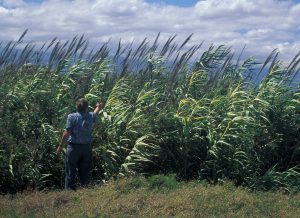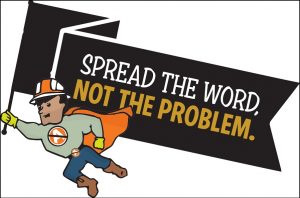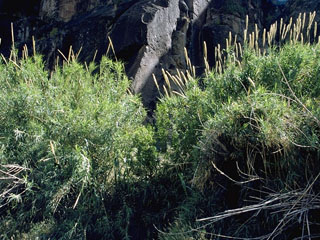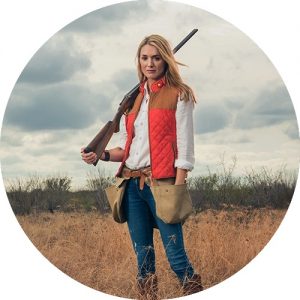May 4th, 2018

Arundo Donax, Image USGS
This is Passport to Texas
Texas Parks and Wildlife rolled out a new campaign on management of an invasive grass called Arundo Donax.
Angela England, an aquatic invasive species biologist, says learn to recognize the plant; say something if you see it, and be aware of its presence.
A lot of it you’ll see on the right-of-ways of the roads—but also in the creeks and rivers. On the banks.
The program reaches out to people in construction and road maintenance. The most effective management is herbicide use.
It doesn’t spread by seed. It only spreads by fragments of the roots and stems. So, any time there is construction activity, or veg management with mowing or tilling that will create these new fragments and spread them around—that’s just creating whole new patches that will be a problem later.
Monica McGarrity, aquatic invasive team leader says the campaign employs a character called Arundo Control Man—an everyday hero.
Everyone can be an Arundo control hero. Everyone can help to manage it. This is a training program that we’re asking everyone to put into play for their safety trainings; it’s plug and play. You can order brochures from us online. You can click play on the video, and train these groups so that all of them can become Arundo control heroes. And that’s what we’re trying to encourage.
Find a link to additional resources at passporttotexas.org.
The Wildlife Restoration program supports our series.
For Texas Parks and Wildlife, Cecilia Nasti.
Posted in Aquatic invasives, Arundo Donax, Texas Invasives | Comments Off on Down with Donax
May 3rd, 2018

Arundo Control Man
This is Passport to Texas
A tall, non-native invasive grass, Arundo donax grows along creek and river beds and spreads quickly. It impairs native ecology, destabilizes and impedes bank access and increases flood and fire risks.
We’re really seeing that the source of this plant getting into our waterways seems to be construction activities, fill dirt placement, and mowing that pulls it down into our creeks.
Monica McGarrity is aquatic invasive species team leader for Texas Parks and Wildlife. Angela England also works on this team as a biologist. She says the agency’s launched a new Arundo awareness and prevention campaign developed in partnership with the Nueces River Authority, Texas A&M AgriLife Extension and the Texas Department of Transportation.
[In] this new program, we’ve geared a lot of the materials to folks in the construction industry and vegetation management. So, mowers, and folks running dozers, and so forth.
England says prevention and management begins with knowing the enemy.
We want everybody that’s in these industries to have a feel for what the plant is. We’ve got a training video; we’ve got materials that we can get to you on how to identify it. We want you to sound the alarm if you see it—and let your boss know: “Hey, it looks like there’s fragments of this bad stuff in the fill dirt that we just got. Maybe we should send it back.” And start hitting it before it gets into new places.
More on the Arundo donax campaign tomorrow.
The Wildlife Restoration program supports our series.
For Texas Parks and Wildlife, Cecilia Nasti.
Posted in Aquatic invasives, Arundo Donax, Habitat, Texas Invasives | Comments Off on Arundo: Donax, do Tell
May 2nd, 2018

Arundo donax, also called Giant Reed.
This is Passport to Texas
Have you seen thickets of plants along roadsides that look like a cross between corn and bamboo? It’s called Arundo donax.
It’s a tall, tall, tall grass. It grows up to 30 feet tall.
Angela England is an aquatic invasive species biologist with Texas Parks and Wildlife. This giant grass thrives along creek and river beds. Growing up to two inches per day, Arundo outcompetes native plant communities.
After the Arundo moves in and forms a real thick area, we see almost no native plants growing there. And we really depend on those native plants to preserve the soil of those stream banks.
Arundo is also a glutton for water.
Arundo is so thirsty, it takes up a lot of water and evaporates it out to the sky. And so, downstream of thick infestations, we actually see less water in the river. And that’s really a problem for fish and other animals that require that water.
A growing partnership to fight infestations of Arundo in Texas. That’s tomorrow.
The Wildlife Restoration program supports our series.
For Texas Parks and Wildlife, Cecilia Nasti.
Posted in Arundo Donax, Habitat, Texas Invasives | Comments Off on Arundo Donax–an Invasive Cane
May 1st, 2018

Surf’s up in Corpus Christi. Image from http://www.visitcorpuschristitx.org
This is Passport to Texas
While you won’t find world-class waves along Texas’ 367 miles of coastline, you will find a legion of surfing enthusiasts engaging the sport with almost cult-like fanaticism.
And in the May issue of Texas Parks and Wildlife magazine writer, Dave Brown, introduces readers to competitive surfers, in his article: Epic Texas Challenge — Texas Surfing Championships.
Brown puts readers in the middle of the action at the Texas Gulf Surfing Association State Surfing Championships, held each spring at Bob Hall Pier in Corpus Christi.
In the article, we meet surfers, including nine-year-old Keagan Sohls who won the state champion titles in both the Menehune and Micro-Grom divisions. And longtime surfer, Brett Hopkins, who is a grandfather.
Brown writes: There weren’t many surfers in Texas before 1960, but by 1965 that changed. Perhaps due to the Beach Boys romanticizing the sport.
Whet your appetite for surfing with Dave Brown’s article: Epic Texas Challenge — Texas Surfing Championships in the May issue of Texas Parks and Wildlife magazine.
That’s our show…. brought to you in part by Ram trucks: built to serve.
For Texas Parks and Wildlife…I’m Cecilia Nasti.
Posted in Events, Nature Tourism, Saltwater, TPW Mag | Comments Off on TPW Magazine: Texas Surfing Championships
April 30th, 2018

Adrian Sabom
This is Passport to Texas
Lifelong outdoorswoman, Adrian Sabom, grew up on a working cattle ranch in South Texas. Her parents, passionate land stewards and avid quail hunters, raised her to respect and protect the beauty of wild things. Taking a page from her folks’ “parenting handbook”, Adrian exposes her two kids to rich outdoor experiences.
When they were little we would take them somewhere where you could go our and just romp around. And then we would take them to South Texas as often as we could, and go hunting. Two weeks ago we went down to see my parents and took [the kids] hunting; they love it. You’re out, all day long, and you have such good conversation where you can just talk about whatever. You just don’t get that opportunity that much.
Sabom encourages parents to share the gift of wild spaces with their children so that their children will have them enjoy in the future.
You know, if we live in San Antonio and we just keep them in the city, that’s what they’re going to know. So, we make sure we take them [outdoors] and do things, so they’re exposed to it, so then they appreciate it.
Learn more about connecting with and conserving Texas wild places during Texas Parks and Wildlife Foundation’s We Will not be Tamed campaign. Find details at tpwf.org.
For Texas Parks and Wildlife…I’m Cecilia Nasti.
Posted in Texas Parks and Wildlife Foundation | Comments Off on There’s No Taming Adrian Sabom







 Passport to Texas is a
Passport to Texas is a  Passport to Texas is made available by:
Passport to Texas is made available by: